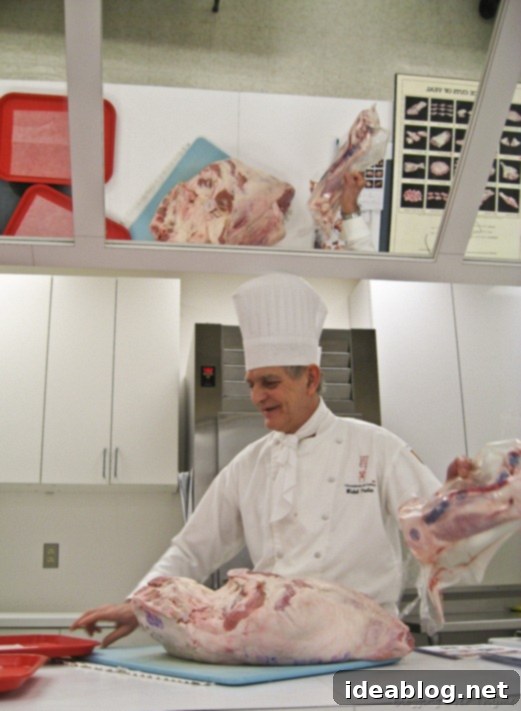Mastering Classic French Cuisine: A Culinary Day Featuring Artichoke Salad, Chicken Chasseur, and Expert Butchery
The journey through classic French culinary arts is an exhilarating one, filled with continuous learning and delightful discoveries. Each day in the kitchen brings new techniques, intricate recipes, and a deeper understanding of the traditions that define this renowned cuisine. Today, I’m eager to share the details of a particularly engaging class, where we delved into a trio of foundational dishes and an essential professional skill. Staying current with these posts is crucial for capturing every nuance and memory, so before the day’s lessons fade, let’s explore the culinary adventures that unfolded.
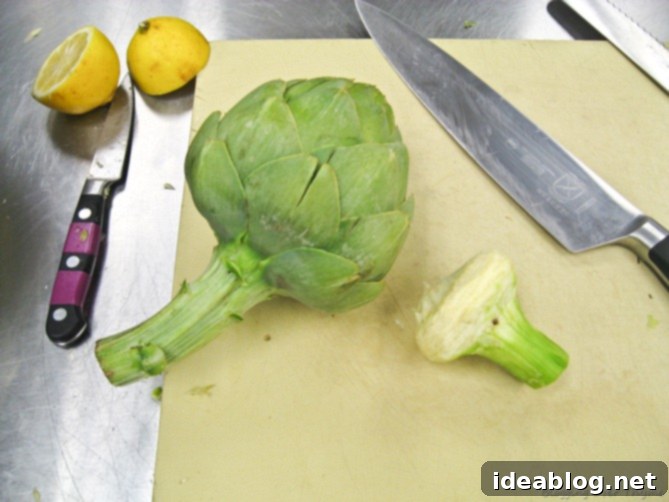
Our culinary session commenced with a refreshing appetizer: La Salade de Fonds Artichauts à la Grecque. This elegant marinated artichoke salad, a staple in French bistro fare, showcased the delicate flavors of artichoke hearts infused with bright, aromatic notes. We specifically utilized the beautifully prepared artichoke hearts from our previous class, ensuring perfect tenderness and flavor. The “à la Grecque” style, as its name suggests, involves cooking or marinating vegetables in a flavorful broth typically consisting of olive oil, white wine, lemon juice, and an array of herbs and spices – with coriander seeds being a prominent flavor in this particular rendition. This method yields a bright, tangy, and incredibly fresh salad, ideal for stimulating the palate.
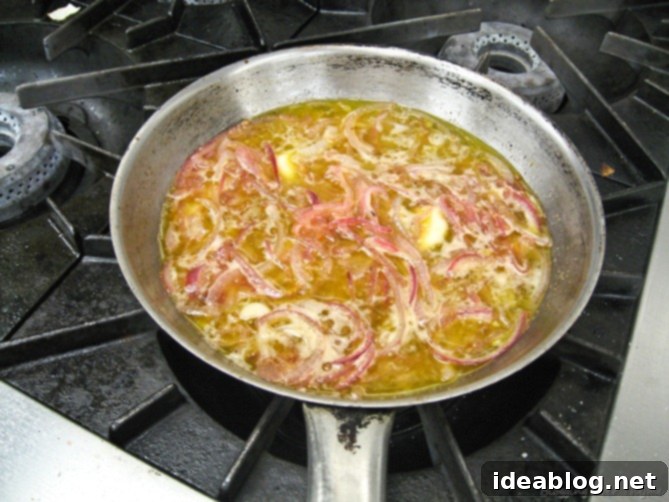
The preparation for this exquisite salad began by gently sweating finely sliced red onions in a generous amount of high-quality olive oil. This step is crucial, as the infused oil would form the base of our vinaigrette-like marinade. To this fragrant base, we incorporated fresh lemon juice, crisp white wine, and the distinctive aroma of coriander seeds, which impart a warm, citrusy, and slightly nutty flavor. The previously prepared, tender artichoke hearts were then added to this aromatic mixture, allowing them to gently marinate and absorb the complex flavors until it was time for service. This gentle marination process ensures that each bite of artichoke is bursting with the vibrant essence of the dressing.
For plating, the marinated artichoke hearts were delicately arranged over a bed of fresh watercress. While watercress provided a peppery contrast, any delicate green, such as arugula or even tender baby spinach, would also beautifully complement the dish. The final presentation was undeniably appealing, though I personally found the vinaigrette a touch too rich in olive oil for my preference. Nevertheless, it served as an excellent demonstration of the ‘à la Grecque’ technique, a versatile preparation method that can be applied to various vegetables, from mushrooms to leeks.
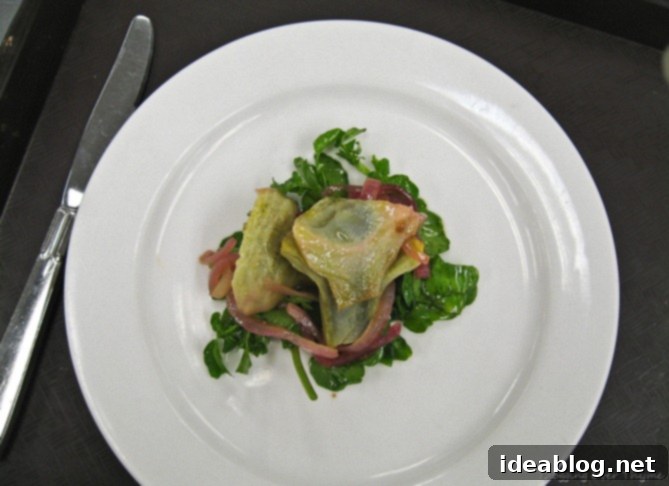
Moving on to the main course, we prepared a hearty and flavorful stew: Le Poulet Sauté Chasseur. The term “Chasseur” translates to “hunter” in French, indicating a dish traditionally prepared with ingredients a hunter might gather, such as wild mushrooms and herbs. This classic French stew featured succulent chicken legs and thighs, making it an ideal choice for slow cooking as these cuts become incredibly tender and flavorful. The rich sauce was enhanced with chopped tomatoes, sautéed mushrooms, and a generous touch of fresh tarragon. Tarragon, with its distinct anise-like flavor, is particularly complementary to chicken and mushrooms, adding an aromatic depth that is quintessential to this dish.
I confess, I hadn’t used tarragon much in my home cooking before this experience, but its unique profile proved to be a perfect match for the other ingredients in this stew.
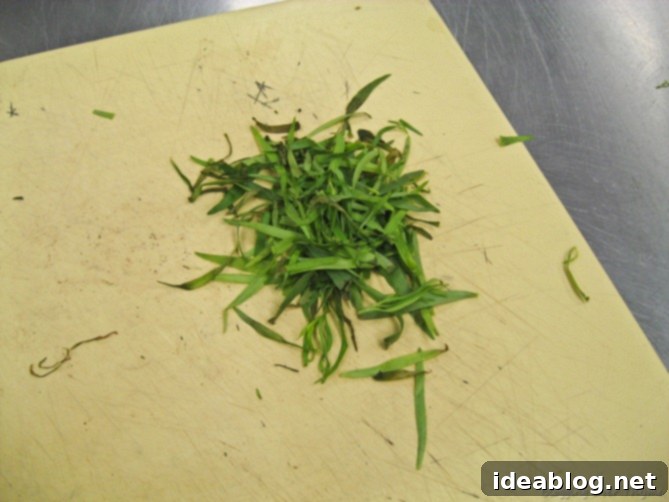
The cooking process for Le Poulet Sauté Chasseur followed a classic French stewing methodology. We began by lightly dusting the chicken pieces with flour, which helps create a beautiful brown crust and thickens the sauce. These floured chicken cuts were then expertly seared in a hot pan until golden brown, locking in their juices and developing rich flavors. Following the searing, the pan was deglazed with a mirepoix (a foundational aromatic base of diced onions, carrots, and celery) and robust red wine, scraping up all the delicious browned bits from the bottom of the pan. This flavorful liquid was then fortified with a substantial amount of rich chicken stock. The seared chicken was returned to this simmering sauce and gently braised in the oven until it reached an exquisite tenderness, literally falling off the bone. This slow cooking method ensures maximum flavor extraction and an incredibly moist and satisfying main course.
Chicken drumsticks and thighs are perfectly suited for dishes like this, as their higher fat content and connective tissues break down beautifully during prolonged cooking, resulting in a supremely tender texture. The depth of flavor developed through the searing, deglazing, and slow braising process creates a truly comforting and sophisticated main dish, highlighting the elegance of traditional French country cooking.
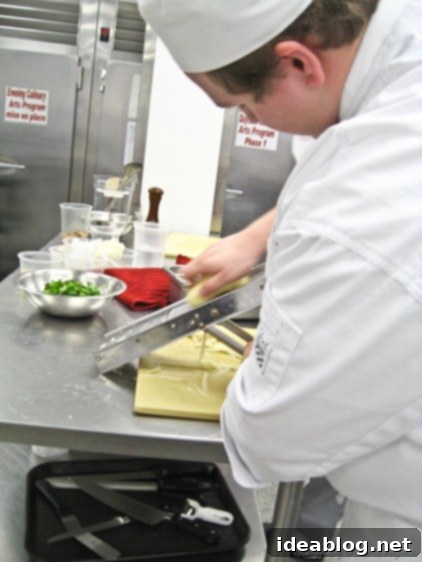
To accompany our robust chicken stew, we prepared a delightful side dish known as Pomme Darphin. This classic French potato preparation is essentially a crispy potato pancake, characterized by its remarkably fine julienned potatoes. For our class, we used charmingly small pans, approximately 2.5 inches in diameter, but the beauty of Pomme Darphin lies in its adaptability – it can be scaled up to any size. The process begins with seasoning the pans with clarified butter, which prevents sticking and promotes even browning. A generous amount of seasoned julienned potatoes is then pressed into the pan and cooked until beautifully golden brown on both sides, ensuring they are perfectly cooked through to a tender interior while maintaining a wonderfully crisp exterior. These delicate potato pancakes are incredibly versatile and could easily complement a wide array of dishes, from roasted meats to fish.
They are so fundamental, in fact, that they will be featured on our next practical exam—eek!
Interestingly, this class also marked our official introduction to the mandoline slicer. While we’ve honed our knife skills by hand-julienning everything previously, the mandoline (as seen in action above) is an undeniable time-saver for tasks requiring uniform, ultra-thin slices or juliennes. However, this efficiency comes with a significant caveat: safety. The mandoline is notoriously sharp and, regrettably, our school does not provide hand guards. This means extreme caution and focused technique are paramount when using this powerful kitchen tool, underscoring the importance of precision and awareness in a professional culinary environment.
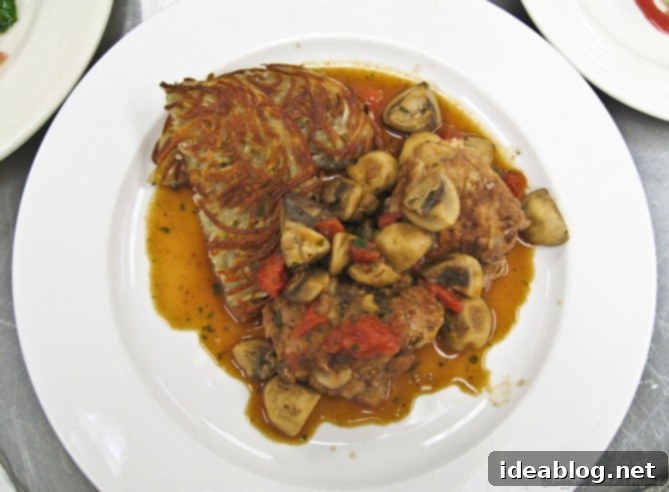
To conclude our elaborate meal, we crafted a magnificent and truly fancy dessert: a classic French Napoleon, also widely known as a Mille-Feuille (meaning “thousand leaves,” referring to its many flaky layers). This iconic pastry features layers of exquisitely crisp puff pastry interleaved with rich, velvety pastry cream, and finished with delicate toasted almonds. The preparation is meticulous but incredibly rewarding, resulting in a dessert that is as visually stunning as it is delicious.
Our process began with rolling out homemade puff pastry dough to a very thin consistency. (We had dedicated time to prepare another batch of this intricate dough on our own, emphasizing the commitment required for such layered pastries.) The rolled pastry was then “docked” – pricked with a fork to prevent excessive puffing and ensure even baking – and lightly dusted with sugar to promote caramelization and a golden hue. This prepared pastry was then baked until perfectly crisp and golden. Once cooled, it was carefully portioned into three equal, rectangular lengths, ready for assembly.
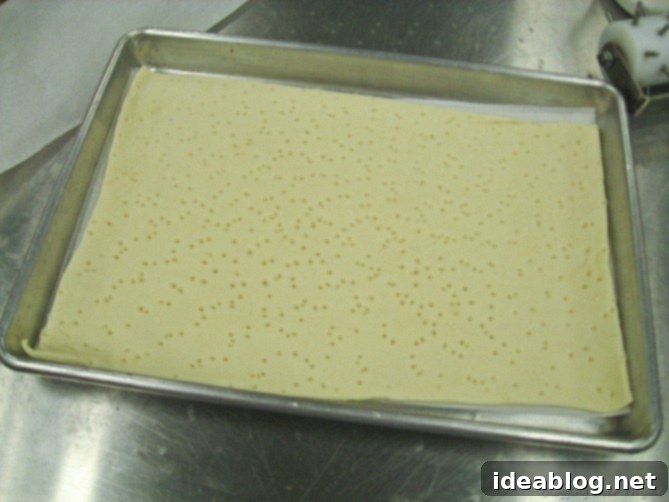
Next, we meticulously assembled the Napoleon. Layers of the crisp puff pastry were generously spread with our luscious pastry cream, which had gelatin added to ensure extra stability and a smooth, luxurious texture. The sides of the assembled pastry were then coated with finely sliced, toasted almonds, adding a delightful crunch and nutty flavor. The top layer of puff pastry was elegantly dusted with powdered sugar, setting the stage for the most exciting and unique part of the presentation.
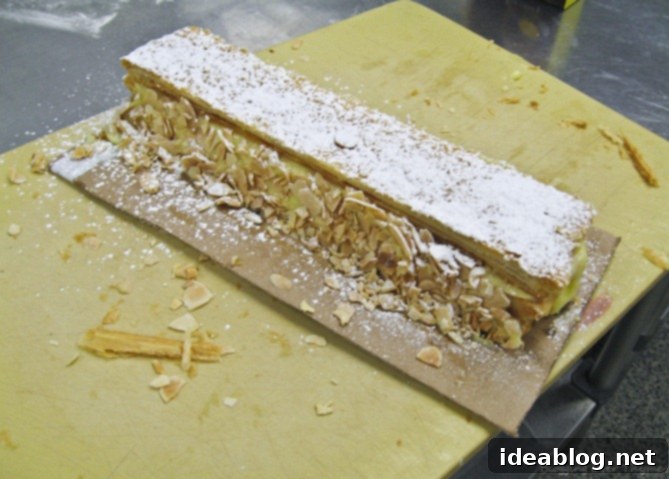
For a truly distinctive finish, we employed a specialized technique: using metal skewers, heated over a gas flame, to carefully scorch and create intricate diagonal marks across the powdered sugar top. This isn’t merely for aesthetic appeal; by literally burning the sugar, we create a thin layer of dark, caramelized sugar, which introduces a wonderful, subtle bitterness to the dessert. This bitterness skillfully cuts through the inherent sweetness of the pastry cream and powdered sugar, creating a more balanced and sophisticated flavor profile. It was a truly fun and engaging dessert to bring to life, though it demanded a swift and coordinated effort at the very end of our service to ensure everything was completed on time. We served our beautifully sliced Napoleons atop a vibrant strawberry puree, playfully shaped into hearts, to celebrate Valentine’s Day! It was a testament to the fact that even classic French desserts can be given a personal, festive touch.
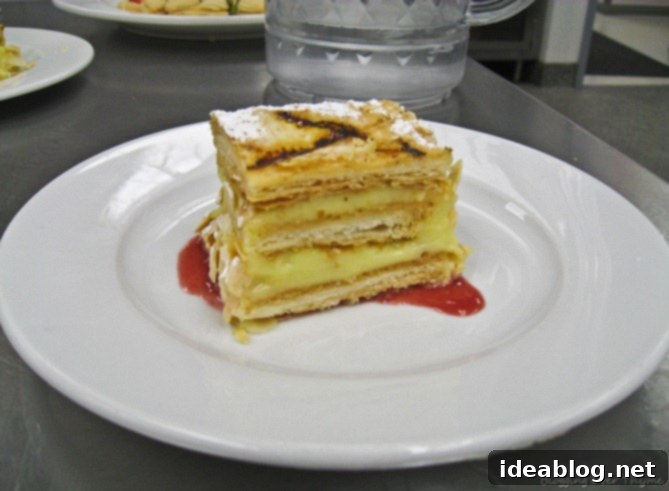
As is customary every Tuesday afternoon, our intensive day concluded with an exceptionally insightful meat lecture. This particular session featured Chef Michel, a distinguished instructor from Phase II of the program, who demonstrated the complete breakdown of an entire leg of veal. This impressive cut weighed a substantial 55 pounds, and Chef Michel, with remarkable precision and efficiency, meticulously deconstructed it into various usable components. His expertise was truly astounding; he once held the incredible ability to perform this entire butchering process in a mere 20 minutes, a testament to years of dedicated practice and deep anatomical understanding.
The emphasis on comprehensive butchery skills at L’Academie is one of its distinguishing features. In an era where many culinary schools no longer teach meat fabrication in such depth – or, in some cases, at all – L’Academie recognizes its immense value. This skill set is not only fundamental to understanding the raw ingredients but also offers significant practical and financial advantages in the culinary industry. For a chef or restaurateur, the ability to break down whole primals or sub-primals rather than purchasing pre-portioned cuts can lead to substantial cost savings, potentially amounting to thousands of dollars annually. Beyond the financial aspect, it is an invaluable and highly respected skill, demonstrating a profound knowledge of ingredients, reducing waste, and offering greater control over the final product.
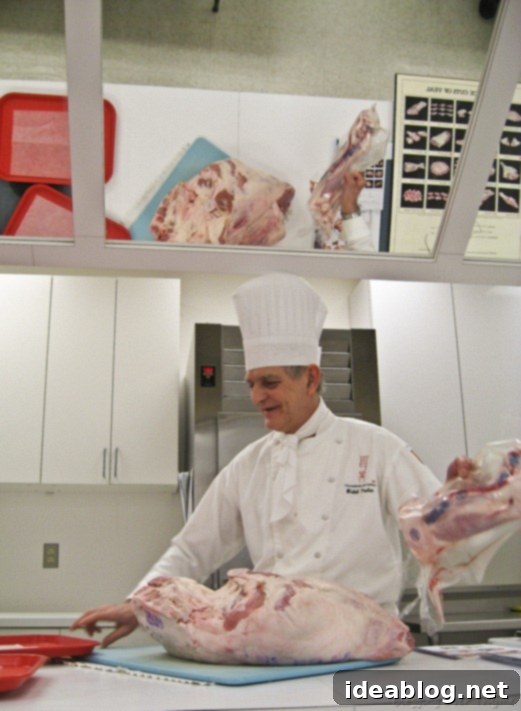
For example: To illustrate the financial impact, Chef Michel explained that the 55-pound leg of veal we observed cost approximately $350, or roughly $6 per pound. However, by skillfully breaking it down into individual cuts – such as tenderloin, top round, sirloin, and osso buco – and then accurately portioning and costing these items for a menu, a restaurant could realistically generate up to an astonishing $3000 in revenue from that single leg. This incredible profit margin highlights the economic power of in-house butchery, especially when compared to the significantly higher costs associated with ordering pre-fabricated, portion-controlled meat cuts from suppliers. This mastery of meat fabrication not only maximizes yield but also ensures superior quality and freshness, providing a distinct competitive edge in the demanding culinary world.
And with that comprehensive overview of our day’s activities, it’s time to rest. Tomorrow promises yet another exciting day in the bustling kitchen, but I will reserve those details for future posts. Let’s just say that our upcoming lessons will involve a significant and thrilling departure from the traditional French fare we’ve been immersing ourselves in, promising new flavors and techniques to explore!
